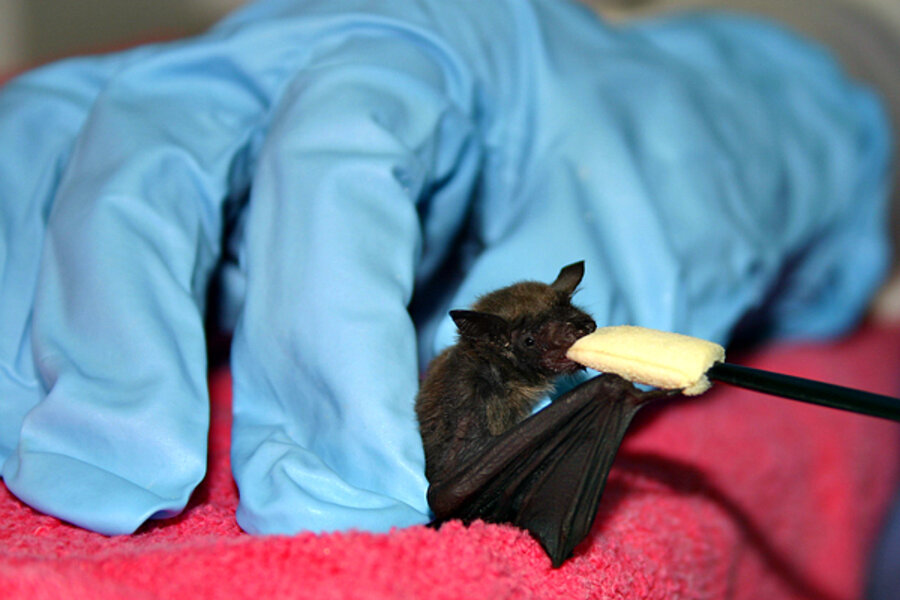Wildlife in Crisis helps 5,000 animals return to the wild each year
Loading...
| Weston, Conn.
Inside one of several aviaries a parliament of owls perches on a branch, watching and waiting until they are fit for release.
The Barred owls are recuperating here at Wildlife in Crisis (WIC), a nonprofit organization that helps heal more than 5,000 wounded, ill, and orphaned wild animals a year. While it specializes in songbirds and birds of prey, WIC also nurtures animals such as fox and skunks, fisher cats and bobcats. Eventually, nearly every animal under WIC’s care will be released.
“They are very wild when we release them. If they aren’t we are not doing our job,” says Dara Reid, WIC’s founder and director. To ensure success each animal has no more than two human caretakers at a time.
Ms. Reid, who has a background in veterinary science and wildlife biology, started WIC in 1988. She had seen how suburban sprawl affected native animal populations.
The increased pace of development helps explain why so many birds of prey are recovering at this center deep within the woods of Weston, located about 45 miles northeast of New York City. In Connecticut roads often follow the tree line. So when a hawk swoops down for a kill it risks injury by car or truck.
“All the animals are brought to us by people who care,” Reid says. “We are the front line of defense for animals.”
The story of WIC also tells the story of Connecticut’s wildlife resurgence, says Dara’s husband, Peter Reid. The now-banned pesticide DDT had killed thousands of predatory birds.
“Thirty years ago you never saw a red-tailed hawk. Now the population is exploding, they are the dominant species in Connecticut,” he says, walking past an enormous outdoor cage holding recuperating red-tail hawks. Birds are released once they can feed, perch, and fly unassisted.
The Connecticut Department of Energy and Environmental Protection and the US Fish and Wildlife Service license WIC. It's the only organization of its kind in the state. Volunteers from around the United States and abroad tend to the animals, housed in wooden buildings on the property.
Inside the animal clinic a hawk with an injured wing perches on the cage of a blind blue jay. On one counter three bats in separate cages hang, wings curled over their tiny bodies. Woody a mallard duck who has imprinted on humans, quacks noisily. Woody and the hawk are WIC’s odd birds: They no longer possess the necessary skills to survive in the wild.
Actor and director James Naughton became involved with WIC several years ago after finding an injured fawn curled under a fern in his yard. The high level of care and dedication of its volunteer staff impressed Mr. Naughton.
“It’s been a mom and pop operation for so long. It’s been Dara and Peter and the interns who work all day and all night for nothing,” Naughton says. “Fortunately, there is an expanding group of people who recognize the worth of what they’re doing. There are a lot of people out there who get very moved about what happens to animals.”
Still, many nature centers are exiting the business of care and conservation because “it’s just too costly and labor intensive,” Mr. Reid says.
Many of the animals, particularly the orphaned babies, require feedings every 20 minutes to 30 minutes. Donations and fundraisers such as the one held Oct. 21 at the Greenwich Audubon Center are vital to WIC’s health.
Through its education efforts WIC busts myths. For example, raccoons seen during the day aren’t necessarily rabid. Mother raccoons are usually searching for extra food for their babies. Moreover, less than 1 percent of bats have rabies. And mother birds won’t reject their young if they are touched by a human hand.
WIC fields about 15,000 calls a year, often dispensing advice – such as don’t give milk to baby birds – on the phone. However, sometimes an animal needs intensive care.
“I was shocked by the terrible condition some of the animals are in when they come in,” says Anna Clark, who interned at WIC.
Now working at the Rainforest Alliance in New York City, Ms. Clark recounted the time a badly injured snake came in. It had gotten caught in a mousetrap. After three weeks of intensive care, the snake was sent slithering on its way.
“It’s always bittersweet to release the animals. You really fall in love with these creatures,” Clark says. “Dara puts an unending amount of love and care into any animal that comes in, regardless of whether it’s an endangered owl or a common sparrow.”
• Sign up to receive a weekly selection of practical and inspiring Change Agent articles by clicking here.







